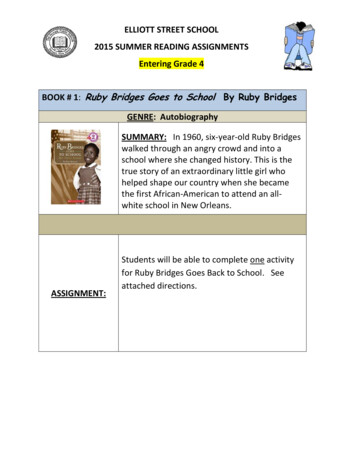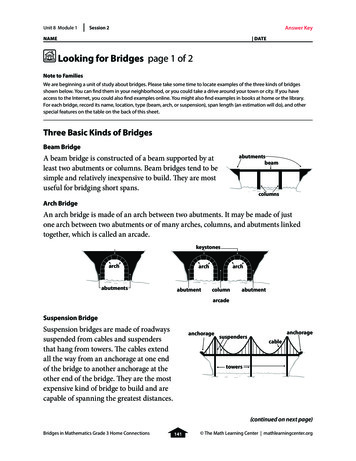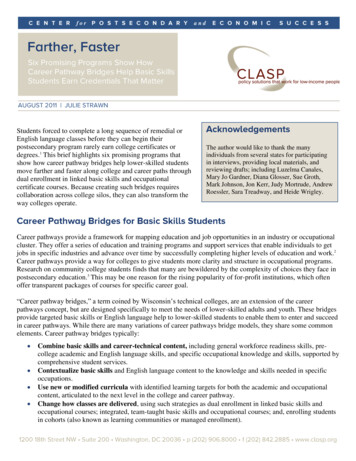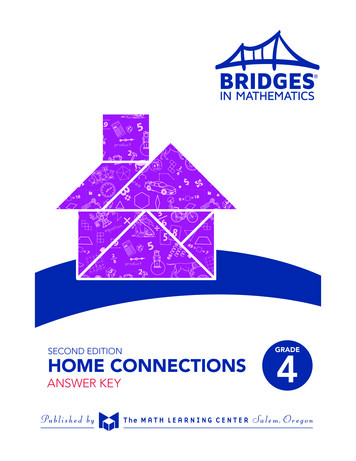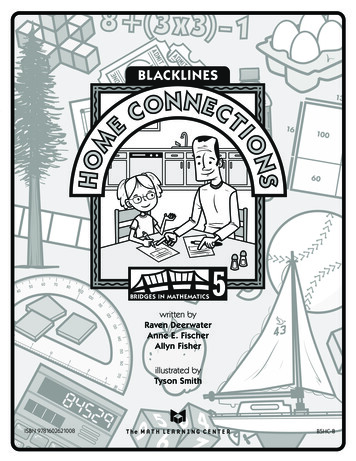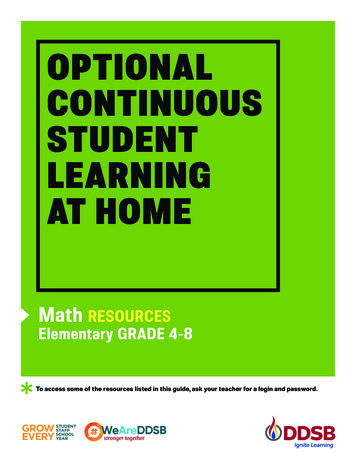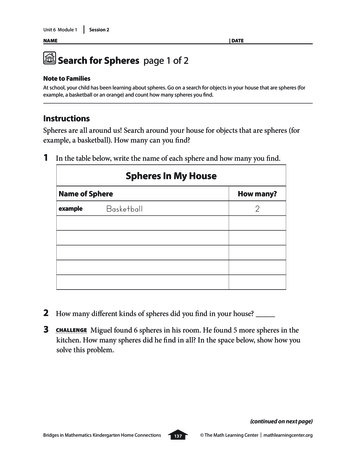
Transcription
Unit 6 Module 1Session 2NAME DATESearch for Spheres page 1 of 2Note to FamiliesAt school, your child has been learning about spheres. Go on a search for objects in your house that are spheres (forexample, a basketball or an orange) and count how many spheres you find.InstructionsSpheres are all around us! Search around your house for objects that are spheres (forexample, a basketball). How many can you find?1In the table below, write the name of each sphere and how many you find.Spheres In My HouseName of SphereexampleHow many?Basketball22How many different kinds of spheres did you find in your house?3CHALLENGEMiguel found 6 spheres in his room. He found 5 more spheres in thekitchen. How many spheres did he find in all? In the space below, show how yousolve this problem.(continued on next page)Bridges in Mathematics Kindergarten Home Connections137 The Math Learning Center mathlearningcenter.org
Unit 6 Module 1Session 2NAME DATESearch for Spheres page 2 of 24Use crayons or colored pencils to color in just the spheres.5How many pictures of spheres did you color in?6CHALLENGEWhich pictures could you combine to show 20 spheres?Bridges in Mathematics Kindergarten Home Connections138 The Math Learning Center mathlearningcenter.org
Unit 6 Module 1Session 5NAME DATECylinders & Spheres Race to Twenty page 1 of 3Note to FamiliesAs you play this game, use the words cylinder and sphere to help your child learn them. Talk about and count howmany have been filled in, and remind your child that the heavy black marks indicate five spaces, making it easier tocount on from 5 or 10.Materials Cylinders & Squares Race to Twenty, pages 1–3 4 crayons in different colors paperclip and pencil (to be used as a spinner)Instructions1Decide who will play for cylinders (the ones shaped like a can) and who will play forspheres (the ones shaped like a ball), and pick two crayons each.2On your turn, spin the spinner and color in that many of your shape on yournumber line. (If you spin 3, color 3 of your shape.)3Switch colors on each turn so you can easily see how many you are adding together.Note Sometimes kindergartners will roll a 3 and color in 3 shapes, and then, if theyroll a 5 on their next turn, they will color in 2 more for a total of 5. Instead, makesure the player who rolls a 5 colors in 5 more on that turn. Once they get past 5 or 6filled in, this won’t be an issue.4As you play, talk about who has more and who has less; how many more or less, andhow you know.(continued on next page)Bridges in Mathematics Kindergarten Home Connections139 The Math Learning Center mathlearningcenter.org
Unit 6 Module 1Session 5NAME DATECylinders & Spheres Race to Twenty page 2 of 3Cylinders & Spheres Race to TwentyParent How many cylinders are colored in?Child Four.Parent How do you know?Child Three and 1 more is 4.Parent Great. How many spheres are colored in?Child Seven there are 5 and then 6, 7.Parent All right. So who has more shapes colored in?Child You do. You have 7 and I only have 4.Parent How many more do I have?Child Let’s see 1, 2, 3 (counting the extras)—you have 3 more.As you get farther along the number line, you can ask, “How many more to get to 20?”56Continue taking turns until all the shapes on one player’s number line have beenfilled in. You need to land on 20 exactly.Say or write an equation each time you color more shapes. For example,if you had 4 shapes colored and then color 5 more on your next turn, say or write4 5 9.CHALLENGE(continued on next page)Bridges in Mathematics Kindergarten Home Connections140 The Math Learning Center mathlearningcenter.org
Bridges in Mathematics Kindergarten Home Connections141221133445566778899Cylinders & Spheres Race to Twenty page 3 of 3NAME10 11 12 13 14 15 16 17 18 19 2010 11 12 13 14 15 16 17 18 19 20 DATEUnit 6 Module 1Session 5 The Math Learning Center mathlearningcenter.org
Bridges in Mathematics Kindergarten Home Connections142 The Math Learning Center mathlearningcenter.org
Unit 6 Module 2Session 2NAME DATEShape Bingo page 1 of 4Materials Shape Bingo, pages 1–4envelope to save the cardsgame markers (pennies, dry beans, small pieces of paper, etc.)scissorsInstructions1Cut apart the two bingo boards on page 3 and the cards on page 4, and get somegame markers for you and your partner.2Mix up the cards and put them in the envelope.3Pull out one card at a time. What does the card show? Do you or your partner havea shape on your game boards that matches the card?4If you or your partner have that shape, cover it with a game marker. Cover only oneshape on each turn, even if there are several shapes that match the attribute card.5The first person to cover three shapes in a row in any direction is the winner.6Save the cards and play again this week.7Complete the worksheet on page 2 and return it to your teacher.(continued on next page)Bridges in Mathematics Kindergarten Home Connections143 The Math Learning Center mathlearningcenter.org
Unit 6 Module 2Session 2NAME DATEShape Bingo page 2 of 4Match the shapes.(continued on next page)Bridges in Mathematics Kindergarten Home Connections144 The Math Learning Center mathlearningcenter.org
Unit 6 Module 2Session 2NAME DATEShape Bingo page 3 of 4(continued on next page)Bridges in Mathematics Kindergarten Home Connections145 The Math Learning Center mathlearningcenter.org
Bridges in Mathematics Kindergarten Home Connections146 The Math Learning Center mathlearningcenter.org
Unit 6 Module 2Session 2NAME DATEShape Bingo page 4 of 4Attribute spherecurved sidesstraight sides3 corners4 cornersthree-dimensionalwith curvesthree-dimensionalwith curvesthree-dimensionalwithstraight edgesthree-dimensionalwithstraight edgesBridges in Mathematics Kindergarten Home Connections147 The Math Learning Center mathlearningcenter.org
Bridges in Mathematics Kindergarten Home Connections148 The Math Learning Center mathlearningcenter.org
Unit 6 Module 2Session 5NAME DATEShapes & Spinners Graphing page 1 of 4Note to FamiliesIn this activity, which we have been playing in school, your child can practice identifying and drawing shapes, as wellas making a aterials Shapes & Spinners Graphing, pages 1–4 paperclip and pencil for use as a spinnerInstructions1Use one record sheet (pages 3 and 4) each time you play.2Spin the shapes spinner on page 2. What shape did you land on?3Find that shape on your graph and trace it in the first box at the bottom of the column.4Keep spinning and drawing until one column is filled to the top. Which shape won?5Compare it with the other columns. When you do another graph, do you think thatsame shape will win again?6Play again on the second record sheet sometime this week.7CHALLENGE Keep playing until you have a first, second, and third place winner. Write 1st,2nd, and 3rd at the tops of those columns.When you are done, compare the columns. Write statements to comparetwo columns. (For example, if you have 3 in the squares column and 4 in thehexagons column, write 3 4 and 4 3 on your paper.) Try it again with twodifferent columns.When you are done, add up two of the columns. Write the equation on yourpaper. Try it again with different columns.(continued on next page)Bridges in Mathematics Kindergarten Home Connections149 The Math Learning Center mathlearningcenter.org
Unit 6 Module 2Session 5NAME DATEShapes & Spinners Graphing page 2 of 4(continued on next page)Bridges in Mathematics Kindergarten Home Connections150 The Math Learning Center mathlearningcenter.org
Session 5Shapes & Spinners Graphing page 3 of 4NAME DATE(continued on next page)Unit 6 Module 2Bridges in Mathematics Kindergarten Home Connections151 The Math Learning Center mathlearningcenter.org
Session 5Shapes & Spinners Graphing page 4 of 4NAME DATEUnit 6 Module 2Bridges in Mathematics Kindergarten Home Connections152 The Math Learning Center mathlearningcenter.org
Unit 6 Module 3Session 2NAME DATEHow Many More to Five? page 1 of 2Fill in the equations.ex1 4 55 5 55 5 5 55 5(continued on next page)Bridges in Mathematics Kindergarten Home Connections153 The Math Learning Center mathlearningcenter.org
Unit 6 Module 3Session 2NAME DATEHow Many More to Five? page 2 of 2CHALLENGEFill in the equations. How many more to 10?10 10 1010 10 10Bridges in Mathematics Kindergarten Home Connections154 The Math Learning Center mathlearningcenter.org
Unit 6 Module 3Session 5NAME DATETen & More Bingo page 1 of 4Note to FamiliesWhen you’re playing bingo with your child, encourage counting the cubes on the cards in different ways (by 10s and1s, by 10s and 5s and 1s, and simply by 1s). It takes some students many times of counting by 1s to really trust thatthere are 10 in the row.Materials Ten & More Bingo, pages 1–4 game markers (pennies, dry beans, pieces of cereal, etc.) an envelope for storing the cardsInstructions1Cut apart the cards on pages 2 and 3 and put them in an envelope.2Cut apart the bingo boards on page 4 and give one to each player.3Cover the “FREE” spot on each board with a game marker.4Take turns reaching into the envelope for a card. How many cubes are on the card? How did you count them? Is there another way to count them?5Both players cover the number on their bingo boards.6The first player to get four in a row in any direction wins the game.7Play the game several times this week.8CHALLENGE Play to “blackout”—that’s when the entire board is covered.Write equations for the different ways you can count the cubes on a card. Forexample, for a card that shows 16, you could write “16 10 1 1 1 1 1 1,”or “10 5 1 16,” or “10 6 16,” and so on.(continued on next page)Bridges in Mathematics Kindergarten Home Connections155 The Math Learning Center mathlearningcenter.org
Bridges in Mathematics Kindergarten Home Connections156 The Math Learning Center mathlearningcenter.org
Unit 6 Module 3Session 5NAME DATETen & More Bingo page 2 of 4(continued on next page)Bridges in Mathematics Kindergarten Home Connections157 The Math Learning Center mathlearningcenter.org
Bridges in Mathematics Kindergarten Home Connections158 The Math Learning Center mathlearningcenter.org
Unit 6 Module 3Session 5NAME DATETen & More Bingo page 3 of 4(continued on next page)Bridges in Mathematics Kindergarten Home Connections159 The Math Learning Center mathlearningcenter.org
Bridges in Mathematics Kindergarten Home Connections160 The Math Learning Center mathlearningcenter.org
Unit 6 Module 3Session 5NAME DATETen & More Bingo page 4 of 817202412251315FREEBridges in Mathematics Kindergarten Home Connections161 The Math Learning Center mathlearningcenter.org
Bridges in Mathematics Kindergarten Home Connections162 The Math Learning Center mathlearningcenter.org
Unit 6 Module 4Session 2NAME DATERace You to 20 page 1 of 4Note to FamiliesBe sure to save this game board — you’ll be using it again in the next Home Connection.Materials Race You to 20 , pages 1–4 40 pennies (or any other small item) for 2 players to share paperclip and pencil (for use as a spinner)Instructions1Decide which side of the game board (page 3) each player will use and who will go first.2Take turns spinning the spinner and collecting that number of pennies. If you landon a nickel, you get to collect 5 pennies.3Set the pennies into the boxes on your side of the game board.4Be sure to wait until one player has finished a turn before spinning again.5Count and compare pennies after each round. Who has more pennies? How many more? How much would the other player need to catch up? How many more pennies until each player has 10 ? 15 ? 20 ?(continued on next page)Bridges in Mathematics Kindergarten Home Connections163 The Math Learning Center mathlearningcenter.org
Unit 6 Module 4Session 2NAME DATERace You to 20 page 2 of 46To win, a player must have exactly 20 . If you spin more than you need, you mustwait until your next turn to spin again.7Play the game several times this week.8Complete the What Comes Next? worksheet on page 4 and return it to your teacher.Note Save the game board and pennies for the next Home Connection.9CHALLENGE Write equations that show the amount you have and the amount you still need.For example, for the game shown above, the player on the left would write4 16 20 and the player on the right would write 6 14 20. Write “greater than” and “less than” statements to compare the amounts of thetwo players. For example, for the game shown above, the statements would be4 6 and 6 4.(continued on next page)Bridges in Mathematics Kindergarten Home Connections164 The Math Learning Center mathlearningcenter.org
Session 2Race You to 20 page 3 of 4NAME DATEUnit 6 Module 4Bridges in Mathematics Kindergarten Home Connections165 The Math Learning Center mathlearningcenter.org
Bridges in Mathematics Kindergarten Home Connections166 The Math Learning Center mathlearningcenter.org
Unit 6 Module 4Session 2NAME DATERace You to 20 page 4 of 4What Comes Next?Write the number that comes next when you are counting.91026041835713171520ChallengeBridges in Mathematics Kindergarten Home Connections167 The Math Learning Center mathlearningcenter.org
Unit 6 Module 4Session 5NAME DATERace You to Zero page 1 of 3Materials Race You to Zero, pages 1–3Race You to 20 game board (saved from the last Home Connection)40 pennies (or any small item) for 2 players to sharepaperclip and pencil (for use as a spinner)Instructions1Set 20 pennies on each player’s side of the Race You to 20 game board to begin the game.2Take turns spinning the spinner and removing that number of pennies from yourside of the board. If you land on a nickel, you get to remove 5 pennies.3Be sure to wait until one player has finished a turn before spinning again.4Count and compare pennies after each round. Who has fewer pennies? How many fewer? How many pennies still need to be taken away before each player reaches 0?5To win, a player must have exactly 0. If you spin more than you need to take away,you must wait until your next turn to spin again.(continued on next page)Bridges in Mathematics Kindergarten Home Connections169 The Math Learning Center mathlearningcenter.org
Unit 6 Module 4Session 5NAME DATERace You to Zero page 2 of 36Play the game several times this week.7Complete the What Comes Before? worksheet on page 3 and return it to your teacher.8CHALLENGE Write equations that show the amount of pennies you still have and the amountyou have removed. For example, for the game shown above, the player on theleft would write 17 3 20 and the player on the right would write 15 5 20.Write “greater than” and “less than” statements to compare the amounts of thetwo players. For example, for the game shown above, the statements would be17 15 and 15 17.(continued on next page)Bridges in Mathematics Kindergarten Home Connections170 The Math Learning Center mathlearningcenter.org
Unit 6 Module 4Session 5NAME DATERace You to Zero page 3 of 3What Comes Before?Write the number that comes before when you are counting.89261041835713171520ChallengeBridges in Mathematics Kindergarten Home Connections171 The Math Learning Center mathlearningcenter.org
Bridges in Mathematics Kindergarten Home Connections 137 The Math Learning Center mathlearningcenter.org
